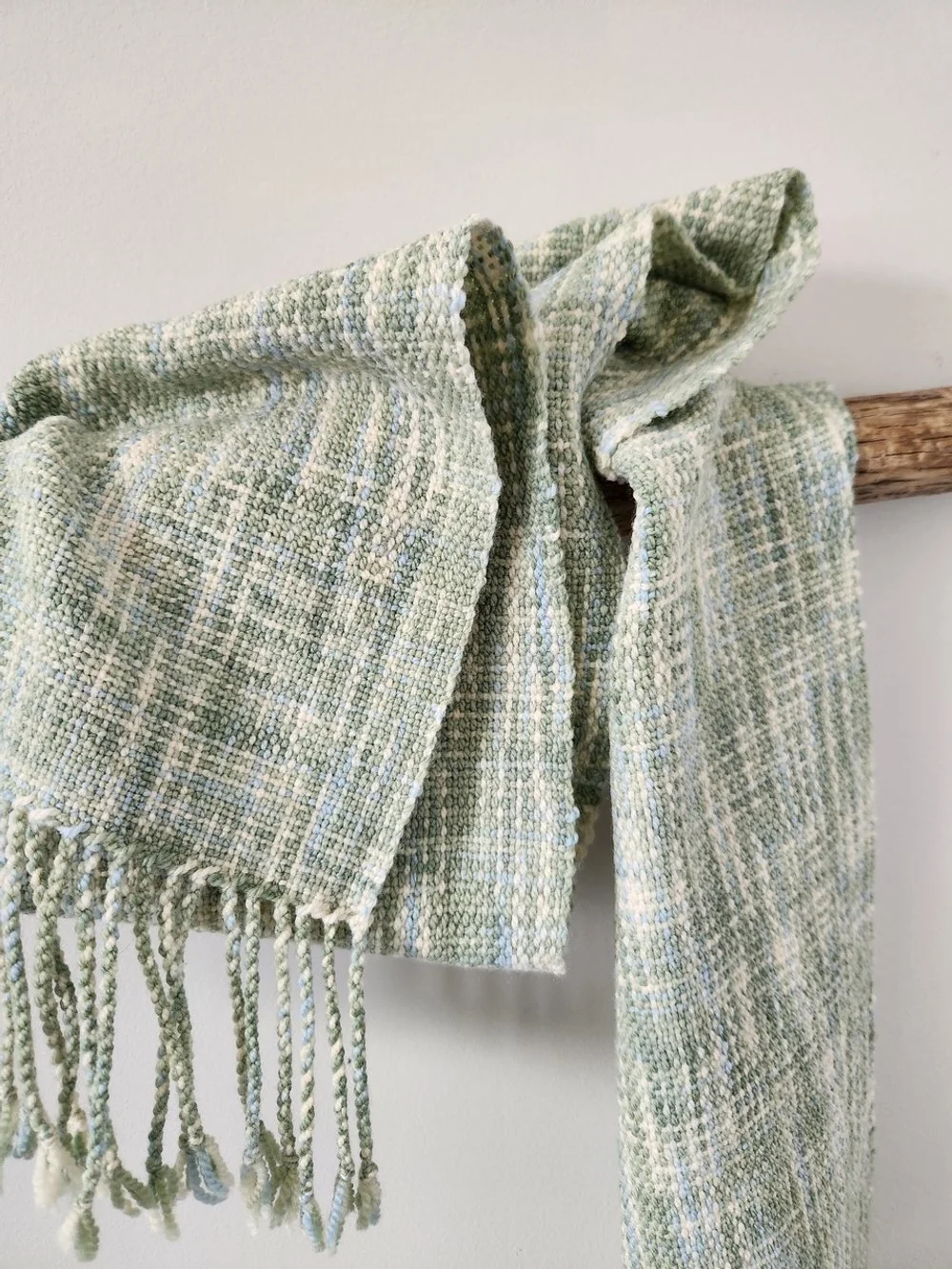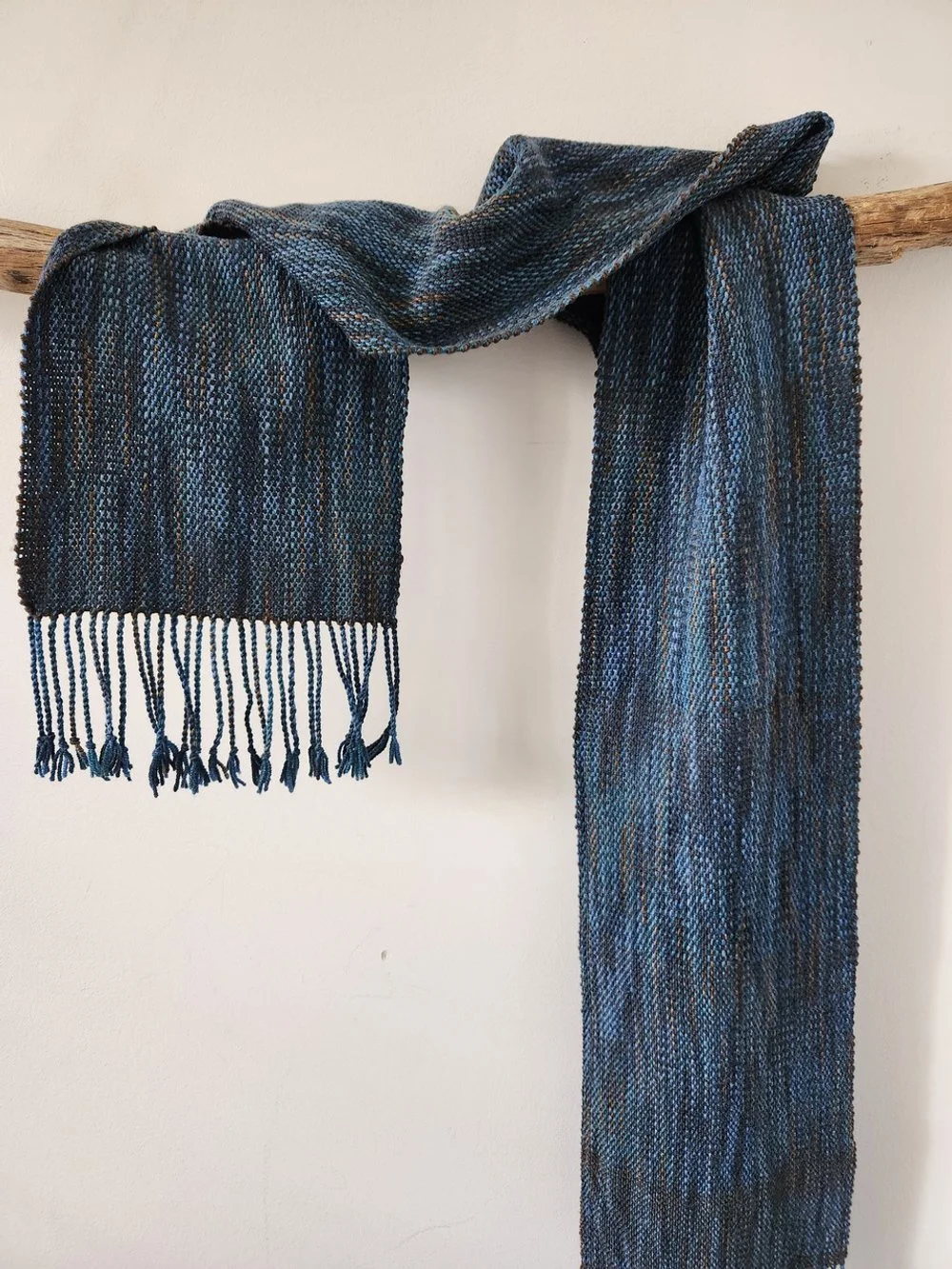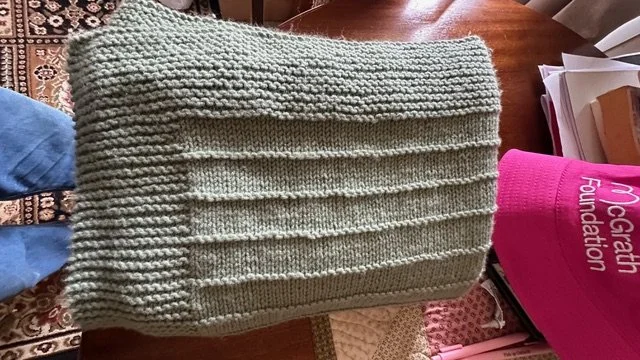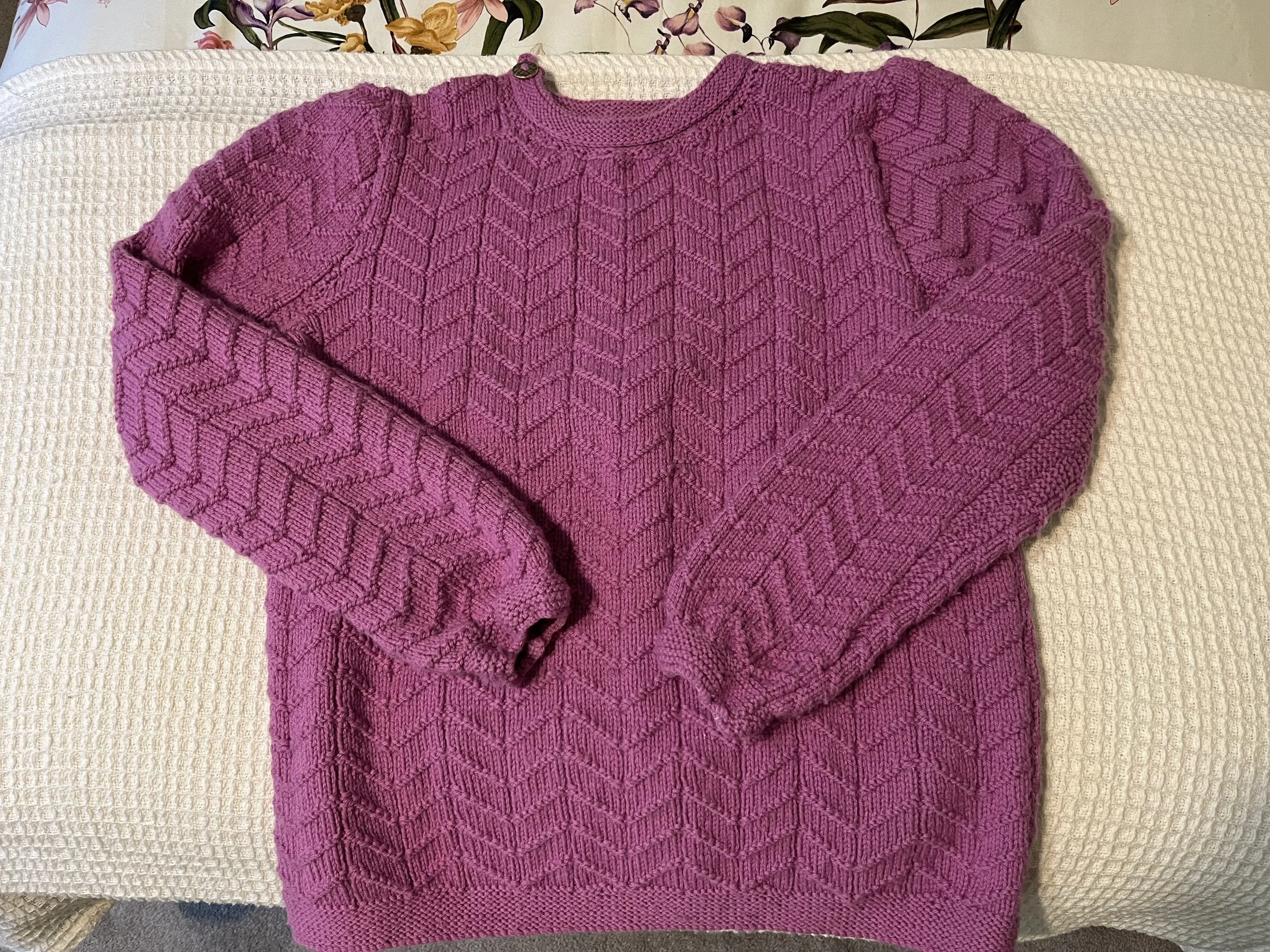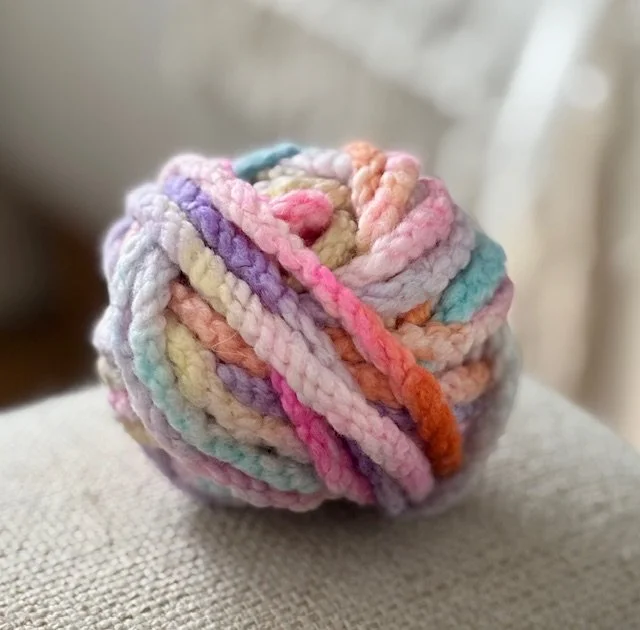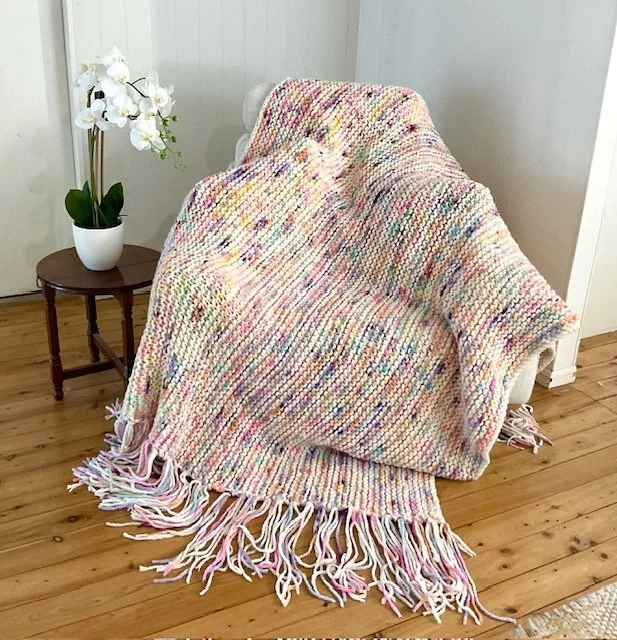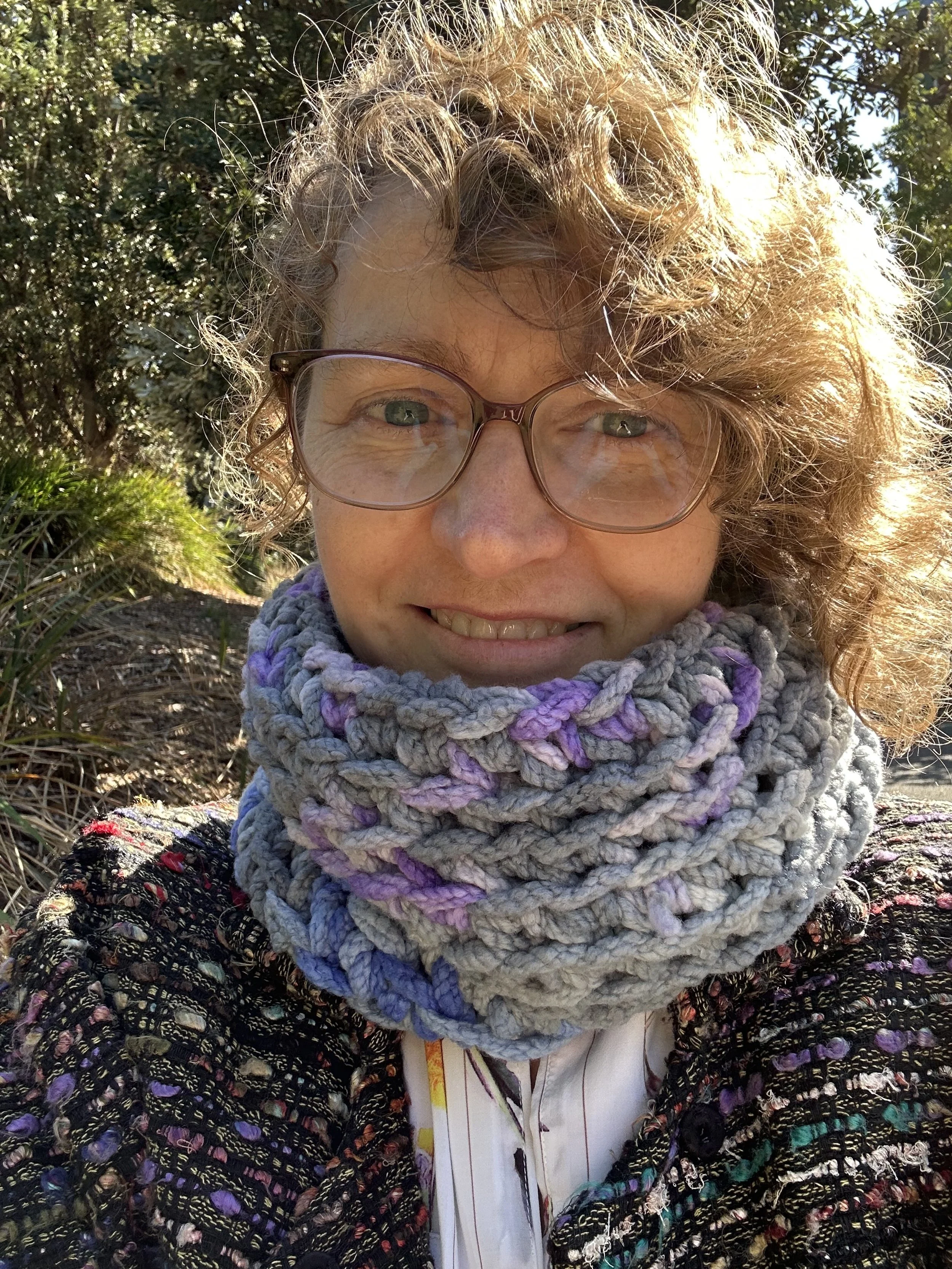Yarn edition: Rope yarn — the silk purse from a sow's ear
Rocky, last year’s pet lamb, checking out the rope yarn colour options!
The rope yarn backstory
I’ve been trying to figure out how to write more engagingly about WGW yarn. Although writing about the farm has become second nature, I struggle a bit with drafting posts about our beautifully soft yarns. Thinking it over, one thing that helps me when I’m coming up with text for a farm post is telling the truth, especially if the joke is on me.
So I thought I’d tell you the true backstory of our rope yarn. Back in 2015, during a visit to our mill in NZ, I came across their ‘dyed-in-the-wool’ heather colours, made by dyeing loose fibres in several different hues and then blending them together. I was enchanted, and decided on the spot to try my hand at a heather colourway.
After much back and forth with the mill, in 2017 we made 300 kg of she-oak heather, blending brown, a blue-green, a rusty red and a bit of gold to mimic the subtle colours of a she-oak grove. We made 200kg into 4- and 8-ply, and reserved 100kg to make into our bouclé, which is where we ran into trouble.
Superfine merino yarn is quite sensitive to heat and agitation, and we have to be careful even when dyeing finished yarn, which is what we do for all of our other colours. The mill uses sacrificial hanks on the metal sides of the vats, to keep the yarn from rubbing and felting. We didn’t anticipate that dyeing the loose fibres might have consequences, too, although the issue was fibres breaking, not felting.
The mill managed to work past the fibre breakage challenge for the 4- and 8-ply ‘ring-spun’ yarns. but when it came to the bouclé, the clumps of short fibres caused the bouclé, a wrapped yarn, to spin up with thicker and thinner sections. The effect was so bad the yarn was unsellable: it looked like something I might have attempted as a novice spinner!
The unsellable thick and thin boucle. If it were intentional, we’d call it art yarn.
A hundred kilograms of wool is a lot to just toss in the tip, so we collectively scratched our heads for a couple of weeks to find a solution. Peter Chatterton, my friend and mentor at Design Spun, finally came up with the idea of plying 4 strands of the clumpy bouclé together to get a rope weight, hoping the thick and thin sections would sort of cancel each other out in the finished yarn. Since we had nothing to lose, we gave it a try, and our rope yarn was born.
I didn’t intend to make more rope yarn — trying to sell 100kg was enough challenge, thanks — but the very next batch of bouclé suffered a different though related fate. Contaminants in the Napier city water supply caused the dye to streak. It was not terribly obvious, but would have showed up in a garment. Peter suggested we try the same rope yarn trick, so another 150kg or so of rope yarn was added to the inventory, in sedge, everlasting and wild orchid.
Within a couple of years demand grew for the rope yarn,
so I began having it made on purpose, and we now carry it in nine colours,
including four stunning gradients from Changeling Coloured Yarns.
On the same trip to NZ in 2015, I visited Hinewai, a reserve on the South Island devoted to the eradication of gorse using botanical succession, using the shade of native trees to kill gorse. The gorse protects the seedlings of the native trees, but once they are grown, the gorse can’t survive in the shade the trees cast. It turns out that she-oaks are our best bet here in Australia to do the same thing.
Click here for a Yarns from the Farm post about Hinewai.
The she-oak nursery — about 35 trees — in a big expanse of gorse on my property. The trees are between 1 and 10 years old, and all self-seeded. Photo credit: Flea McShane and her adorable tiny drone.
Patterns
Rope yarn is beautifully suited to making throws and blankets. See our Cloudfall Blanket pattern and kits for a simple, yet interesting, design. Ravelry.com has lots of patterns from independent designers using super chunky yarns, similar WGW rope yarn.
Here are links to patterns for throws, cowls and scarves, cardigans and pullovers.
If you aren’t familiar with Ravelry, I’d urge you to explore the site. It is full of wonderful patterns and projects, and represents a delightful crafting community.
Years ago I used a pattern I found on Ravelry, Nanaimo Cardigan by designer Tara-Lyn Morrison, when I was experimenting with my then brand-new rope yarn. Though the pattern gauge wasn’t quite the same as WGW rope yarn, it’s pretty close. I loved the weight and shape of Nanaimo, and only regretted that I’d made it as a gift for my step-sister, rather than getting to keep it for myself!
Vivienne Bunt, from Greta’s @ Roseville, made a delightful blanket for her daughter, with Viv’s hand-dyed WGW rope yarn, and is making another for her granddaughter! See the Stockist Highlight section below for more about this charming blanket.
Technical information
WGW rope yarn is what is known as a wrapped yarn. It starts with strands of our bouclé, in which a soft, lightly twisted core of combed top is secured with a fine thread (also made from our wool) in a spiral. With the tremendous loft inherent in WGW fleece, when the yarn is heat set, it plumps up to look and feel more like a chenille than a traditional bouclé, which is loopy and a bit harsh. Our bouclé yarn is considered a ‘chunky’ weight yarn, which we estimate corresponds to about a 12 ply weight.
The rope yarn is made by plying together 4 strands of bouclé, hence its designation as a 48 ply. A more useful descriptor when comparing it with other yarns is probably ‘super chunky’. The gauge is 7 rows and 10 stitches for a 10 cm square swatch, and the meterage is 55 m per 100 g. Care is the same as for all WGW yarns: hand wash in lukewarm water, dry flat. Do not machine wash, though you can have it dry cleaned by a reputable cleaner.
Joining ends of rope yarn can be challenging — weaving in 8 ends for each join gets a bit tedious, and it’s hard to hide them. Lynda from Homelealass sells a needle felting kit for joining super chunky yarns, which I can recommend highly from personal experience.
Gallery of customers’ finished items
We’re delighted to share with you photos from our customers, a tradition we're starting with this yarn edition of Yarns from the Farm.
If you have a project you’d like to share, please click the link below to email a photo and description, including the pattern name, yarn weight and colour.
Stockist highlight
Meet Vivienne Bunt of Greta’s @ Roseville, a destination yarn shop on Sydney’s North Shore. Vivienne creates her own hand-dyed range — Greta’s Hand-Dyed Yarns — to complement the wide range of commercially dyed yarns she stocks.
Hi,
My name is Vivienne, and I am the owner of Greta’s @ Roseville. Greta’s is a retail yarn shop, looking after crocheters and knitters since 1979.
Nine years ago, I decided to start hand dyeing yarn to give my customers a more bespoke shopping experience in beautiful yarns and colours.
Through this journey, I have dyed many brands of yarn. However, 7 years ago, I was introduced to White Gum Wool. Since then, I have dyed all of Nan’s bases, with fabulous results.
Recently my daughter asked me to make her a super chunky blanket, dyed in bright colours. Immediately I thought what a great project to use Nans White Gum Rope yarn!
The Rope Yarn is made with 4 strands of standard boucle, which gives a lovely texture, and is incredibly soft and squishy!
I dyed 5 colours, with careful placement of each colour, as the Rope yarn is very absorbent of the dye: think blotting paper.
With the resulting combination of colour and texture in the rope yarn, I only needed to do a simple garter stitch, nothing complicated.
To finish off, a long fringe on both sides!!
I hope these photos inspire you to experience the WGW Rope yarn in one of your projects ☺
Vivienne
Greta’s @ Roseville
72 Pacific Highway, Roseville NSW 2069
Ph: (02) 9413 2630
IG: @gretasroseville
Garter Stitch Rope Yarn Blanket Pattern
Dimensions: Approx 260cm x 280cm (excluding fringe)
WGW Rope Yarn:
CC: Cream (undyed) x 6 skeins
MC: “Cosy Ripple” by Greta’s Yarn x 12 skeins
Needles: 15mm
Cast on 105 sts using CC
Work in garter stitch as follows:
MC: 2 Rows
CC: 1 Row
Fringe: Cut in 50cm lengths
Featured product: Pixel Life rope yarn and cowl pattern
From Melissa at Changeling Coloured Yarns comes a quick crochet cowl. The pattern calls for a 25 mm hook. I’d recommend Art Viva for their beautiful hand-crafted wooden hooks and needles.












